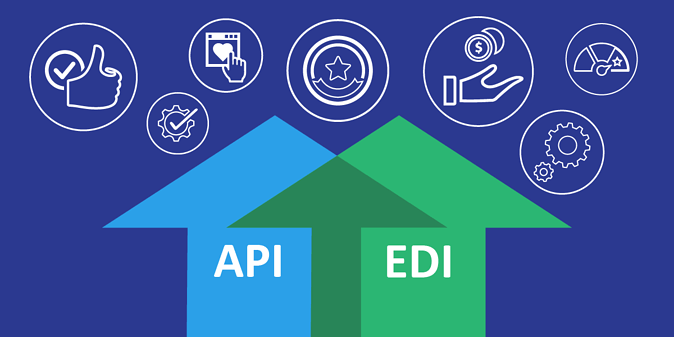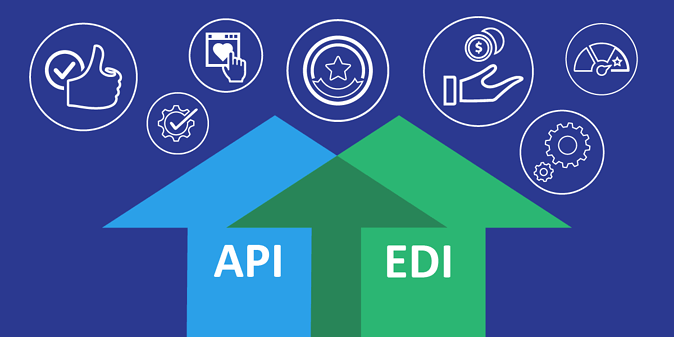My colleague, Jim Cantin, recently wrote an excellent article on “Why APIs and EDI Are More Complementary Than Competitive.”
This is an interesting topic and we get many inquiries from clients who want to explore how they can integrate these two platforms and improve the synergy from both a business and IT perspective. I would like to take this discussion to the next level and offer concrete steps that outline how you can look for opportunities in this space.
The Connection Between APIs and EDIs
Let’s start with a simple view of where to look for synergies. I’ll focus on three areas:
- Where can you supplement your EDI with APIs and give your trading partners access to a suite of transactions and capabilities?
- Where can you improve your EDI success rates by utilizing APIs to add supplemental data to inbound or outbound transactions?
- Where can you combine support processes to both save money and improve the trading partner experience?
Now let’s look at how you can answer these questions to enhance your capabilities.
1. Supplement your EDI with APIs
Jim covered this to some degree in his article. The focus here is to identify situations where your trading partners will want information immediately. This may include transactions that you currently handle via EDI or it may include new transactions that will help the partner submit higher quality EDI. A perfect example comes from the healthcare payer space where an API to check member eligibility then enables the payer to submit an EDI claim with all the correct eligibility information. This avoids errors on the claim transaction plus it helps the payer ensure that the patient has medical coverage before they deliver services. To evaluate possibilities in this space you can take these steps:
- Talk to your trading partners. Where would immediate access to information help their business model?
- Talk to vendors of systems used by your trading partners. What APIs would they like to access for instant information access? The vendors are typically quite willing to discuss this plus they know what their customers want. Getting them on-board will help ensure adoption of your APIs.
- Identify common errors. What are your top transaction errors in the EDI space? Can you provide API lookups that would help your trading partners avoid those errors? These are typically excellent candidates for APIs that would be readily adopted by your partners. They don’t want errors in transactions any more than you do.
2. Improve your EDI success rates by utilizing APIs to add supplemental data to inbound or outbound transactions
With this approach, you will utilize API’s while you are processing your EDI transactions. These API’s will look up information in your backend systems to supplement data, edit errors, etc. The steps to take to analyze these opportunities include:
- Identify Common errors. What are your top transaction errors in the EDI space? Can you access backend datasets to edit or improve the inbound transaction? If so, evaluate building APIs into those data sets.
- Evaluate the internal processes that occur once a transaction is accepted. Many organizations still “process” a portion of their EDI transactions manually once they arrive and have been accepted into the system. Look for opportunities to avoid this costly handling by adding API lookups before the transaction is fed to the downstream system. You may find you can mimic what an operator is doing to process the transaction downstream. This will save you labor costs plus speed up your processing.
Note: in some cases, there may be regulations that prevent you from changing data on inbound transactions. That’s okay, you can still use these techniques by improving your error reporting to the trading partner. Instead of giving a generic error to the partner you can use the lookups discussed above to provide specific information about what needs to be fixed before the transaction is re-submitted. This will win you points with your trading partners and save them costly processing time.
3. Combine support processes to both save money and improve the trading partner experience
In addition to the technical side of bringing your EDI and APIs together, consider ways to combine the support processes. Here are some simple steps to take to evaluate these possibilities:
- Combine support/call centers. Can your trading partners call just one number to get support regardless of the type of transaction? In many companies there are separate areas that handle problems related to EDI vs. APIs. Consider combining this into one contact point or call center. Can your trading partners call just one number to get support regardless of the type of transaction? In many companies there are separate areas that handle problems related to EDI vs. APIs. Consider combining this into one contact point or call center.
- Describe all your services in one place. Can a trading partner go to one place to see all your services and electronic transactions (regardless of format/type of transaction)? If not, you are making it more difficult for them to pick the right services and probably reducing the volume of your electronic transactions. Consider a single portal that describes all EDI, API’s and other trading partner services. Make this portal highly focused on making the process easier for the trading partner. Promote the portal as a one-stop place to evaluate electronic transactions with your company.
- Combine your approval processes. Can a trading partner get approved for electronic transactions in one place? Are the processes (testing, approval, security) for EDI vs. APIs as similar as possible? Consider ways to make these processes uniform. Use these processes to help “sell” further electronic integration. For example, if a client is signing up just for EDI, your team can promote the API opportunities and encourage the partner to integrate more completely.
We often focus on the technical side of integrating and forget about the process. Taking the above steps to combine to the process side of your electronic transactions will save you money and improve your trading partner experience. All of that is good for business.



